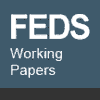
| Finance and Economics Discussion Series |
|---|
 |
Testing for Adverse Selection and Moral Hazard in Consumer Loan Markets Wendy Edelberg 2004-9 |
Abstract: This paper explores the significance of unobservable default risk in mortgage and automobile loan markets.
I develop and estimate a two-period model that allows for heterogeneous forms of simultaneous adverse selection
and moral hazard. Controlling for income levels, loan size and risk aversion, I find robust evidence of adverse
selection, with borrowers self-selecting into contracts with varying interest rates and collateral requirements.
For example, ex-post higher-risk borrowers pledge less collateral and pay higher interest rates. Moreover, there
is strongly suggestive evidence of moral hazard such that collateral is used to induce a borrower's effort to
avoid repayment problems. Thus, loan terms may have a feedback effect on behavior. Also, higher-risk borrowers
are more difficult to induce into exerting effort, explaining the counter-intuitive result that higher-risk
borrowers sometimes pay lower interest rates than observably lower-risk borrowers.
Home | FEDS | List of 2004 FEDS papers
Accessibility
To comment on this site, please fill out our feedback form.
Last update: February 17, 2004